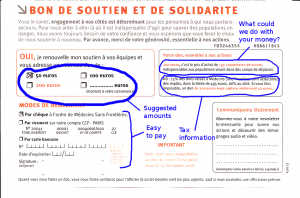November 28, 2008
community, freesoftware, gnome
1 Comment
Friday afternoon I went along to Handicap International’s Centre icom’ here in Lyon, to see what they do first hand, to talk to the people there, and to figure out if there was any way that GNOME could be working better with people like them.
Handicap International, like all of the other groups I have talked to involved in bringing IT to people with disabilities – or indeed to anyone who doesn’t know computing very well – have a natural affinity with Free Software. First, for its price – equivalent proprietary software is expensive. But also for the philosophy of Universal Access that is so important to the GNOME project – that everyone should be able to access IT, regardless of their culture, or their physical or technical ability.

Handicap International Centre icom
We had a great afternoon, including role-playing. I played a deaf person who could lip-read, it was eye-opening to see how long it took for people to realise what my handicap was, when a few extra minutes taken at the start of the session would have helped a lot. We got to try lots of AT, including a golf-cap with a metal tip for controlling the mouse with head movements, and a software face-tracker that worked with an ordinary webcam, both of which brought home just how hard using a computer is if you can’t use a mouse (we used both with dwell-clicking enabled).
It was surprising to see how little specific AT hardware there was – all the PCs were normal, and 90% of what the Centre does is set up preferences, and where necessary use specialised software.
One other thing was surprising – in spite of being aware of Dasher, there is no-one in the center that uses it – they prefer the on-screen keyboard. I wonder if there isn’t room for a dialogue there – and I would definitely like to hear from people using Dasher for actual data entry, to see in what situations it’s adopted.
November 20, 2008
gnome, marketing
7 Comments
Having made a donation previously to Medecins Sans Frontieres, I occasionally receive mail from them solliciting donations. After one year when I didn’t give anything, I received a letter asking if I was unhappy with MSF and the work they were doing, with a detailed presentation of their major actions, and today, just in time for the end of the year, I received another mailing asking if I wanted to give again this year.
The entire mailing fascinated me, especially their donation form.

Medecins sans Frontieres
There was a bunch of stuff I found interesting about this. The letter emphasised that MSF gets very little public funding, and that 99.6% of its funding comes from private benefactors. I got a small glossy newsletter highlighting some of the most important work the organisation has done over the year, and on the donation form itself, there is a suggested amount of €200, which I thought was a bit high. But beside it, they talk about what they can do with that, and how much the donation will really cost you if you pay taxes (and most people do) – in short, if you give €100 to MSF, you’re actually giving them €25 of your own money, and €75 which you would otherwise be paying in taxes.
In other words, they simultaneously speak to your heart and your pocket. Nice work. In addition, they include a postage-paid envelope for you to return your donation. It’s as easy as write a cheque, put it in an envelope, post, done. Having to address the envelope and search for a stamp are barriers to donations, so they take them away.
They also include a brochure for their line of Christmas cards – another money-maker which is also free viral marketing for them. Every occasion is good for raising money for a good cause.
While the GNOME Foundation and MSF are very different organisations, I think there are lessons to learn for the foundation across the board here. We need to keep track of former donors and remind them why they gave, what we’re doing, and ask them to give again. We need to make it as easy as possible, within our means, for them to give. And we need to elaborate the value proposition: what do we do with the money, what good work are you supporting?
These are all things which we’ve been doing, or have done partially, in the past, but seeing all of the steps put together in a simple, nice package really brought home to me how much we need to leverage our donors – they’re people who believe so much in us that they’ve given money, and they can be our best ambassadors.
November 20, 2008
General
10 Comments
Warning: political opinion
On a day of yet another national strike in France, with 60% of teachers on strike (according to the unions) in protest against a recent law on minimum service in schools and other education related issues, I have been thinking about how politics in France is so different to what I knew in Ireland, and what I’ve read about during the recent US presidential campaign.
In France, as in many countries, there is a long-standing tradition of talking about politics in terms of the left and the right. And unlike in the US, it’s considered OK to be a socialist – or even a communist – and we have parties that score between 2 and 5 percent in national elections with names like “The Worker’s Struggle” or “The League of Revolutionary Communists”.
While I think of my political leaning not as one-dimensional, but as multi-dimensional. Your political identity is defined by your relative position on a whole range of subjects. Questions that are interesting to me: what is the place of the state in education, social security, job creation? What should we consider a public service, and what is in the realm of private enterprise? What are the responsibilities of the individual to the state, how much freedom does the individual have, and how much right does the state have to define and limit that freedom? What should the spending priorities of the state be?
When you phrase things in this way, it’s clear to me that the “right wing” of French politics is actually quite left-wing:
- France has a very high rate of social insurance – over 45% taken off every paycheck to pay for pensions, unemployment benefit, healthcare, which is supported by both the right and left wings.
- On top of this, France has a progressive income tax system, which pays for things like the education system, public transport, the army, the environment – all the usual government expenditures
- Universal healthcare of a uniform standard is a fundamental principle in France, which is supported by both the right and the left. You don’t get better healthcare if you pay more here
- Free education, right up to third level education, is considered a fundamental right in France, and the public primary & secondary school system is of a very high quality
On all these issues, both the right and the left in France are in agreement – the role of government is to provide a minimum level of infrastructure, education, healthcare and social security to all of its citizens, in particular those who are living in precarious conditions.
And so I have come to the conclusion that the French right wing majority party (the UMP) is really a fiscally center-left wing party with a slight authoritarian leaning.
I had written a lot more on the areas where the government is trying to cut costs – suffice it to say that I think most of them are reasonable and necessary, and I think that most of the unions in France are, on the contrary, being unreasonable in expecting things to stay the same. It’s funny, but it is the left wing in France today which is more conservative (“leave things the way they are”) and the UMP which is being more progressive.
To be honest, I with that the center-left party (PS) would tackle some of those social questions I asked earlier head on, clearly elaborate their values, and identify their priorities based on those values. I think that their message would be well received.
November 20, 2008
General
6 Comments
I don’t cook often, so when I do, it’s an occasion worth marking.

Boeuf Bourguignon
Boeuf Bourguignon (for 6 people)
Ingredients:
- 1.5kg decent beef, cut into nice sized chunks
- 6 big onions
- 6 carrots
- About 250g of mushrooms
- 100g chopped rashers (lardons, for the frenchies out there)
- About 50g of butter
- 3 soup spoons of plain flour
- A few leaves of bay leaves (thanks J5 for the translation of laurier) and a few twigs of thyme, 12 whole cloves, 12 whole peppercorns, salt to taste
- 1 bottle of drinkable red wine (I used a cheapish bottle of Côte du Rhône)
Preparation:
Cut the onions up into big chunks, and lightly fry them with the rashers in the butter. Remove them, and then brown the meat in the same pan (fairly high heat, just for a minute or two). Sprinkle the flour on and keep going until it’s turned kind of golden. The flour & butter will do the same job as a roux and thicken the sauce.
Move everything (beef, bacon, onion) to a big pot, add the red wine, peppercorns, salt, cloves, and herbs. Leave it cooking on a really low heat (the wine must not boil, or your beef will be leather) for about 2 hours.
Peel & cut the carrots into biggish chunks, wash & chop the mushrooms (again, I like chunky), and when the sauce is nicely reduced, add them to the pot. Leave the lot cooking (still on low heat) for another hour at least.
Serve hot, with boiled or steamed potatoes (you can add them to the pot for a few minutes after boiling and before serving if you like that kind of thing) and a nice Burgundy red.
Best thing about this? You can prepare it in about 20 to 30 minutes at lunchtime, and leave it cooking all afternoon, when it’s done, take it off the heat, and reheat it when your guests arrive. This works best if you work at home.
November 4, 2008
freesoftware, gnome
5 Comments
Big news yesterday! Motorola and Google joined the GNOME Foundation advisory board.
Just let that sink in a little…
Google and Motorola are two huge companies, showing support for, and confidence in, the GNOME project. While it might be possible to dismiss Google’s participation as just helping us out, it’s interesting to see what Christy Wyatt has to say about GNOME and Motorola’s strategy: “For mobile Linux, Motorola believes in open standards and open source technologies”.
What this implies to me is that while Motorola may be trending towards Android for their next generation of smart phones, they’re going to be keeping the MotoMagx option open, even as they turn away from LiMo. Perhaps a small strategic skunkworks project, pottering away and keeping an eye on how things develop?
In any case, I welcome Motorola to the foundation, and I hope that we have a long and fruitful collaboration.


